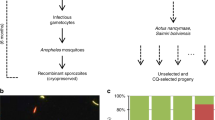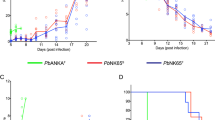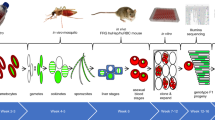Abstract
To identify genetic effects modulating the blood stage replication of the malarial parasite, we phenotyped a group of 25 inbred mouse strains for susceptibility to Plasmodium chabaudi chabaudi AS infection (peak parasitemia, survival). A broad spectrum of responses was observed, with strains such as C57BL/6J being the most resistant (low parasitemia, 100% survival) and strains such as NZW/LacJ and C3HeB/FeJ being extremely susceptible (very high parasitemia and uniform lethality). A number of strains showed intermediate phenotypes and gender-specific effects, suggestive of rich genetic diversity in response to malaria in inbred strains. An F2 progeny was generated from SM/J (susceptible) and C57BL/6J (resistant) parental strains, and was phenotyped for susceptibility to P. chabaudi chabaudi AS. A whole-genome scan in these animals identified the Char1 locus (LOD=7.40) on chromosome 9 as a key regulator of parasite density and pointed to a conserved 0.4-Mb haplotype at Char1 that segregates with susceptibility/resistance to infection. In addition, a second locus was detected in [SM/J × C57BL/6J] F2 mice on the X chromosome (LOD=4.26), which was given the temporary designation Char11. These studies identify a conserved role of Char1 in regulating response to malaria in inbred mouse strains, and provide a prioritized 0.4-Mb interval for the search of positional candidates.
This is a preview of subscription content, access via your institution
Access options
Subscribe to this journal
Receive 6 digital issues and online access to articles
$119.00 per year
only $19.83 per issue
Buy this article
- Purchase on Springer Link
- Instant access to full article PDF
Prices may be subject to local taxes which are calculated during checkout




Similar content being viewed by others
References
Greenwood BM, Fidock DA, Kyle DE, Kappe SH, Alonso PL, Collins FH et al. Malaria: progress, perils, and prospects for eradication. J Clin Invest 2008; 118: 1266–1276.
Dondorp AM, Nosten F, Yi P, Das D, Phyo AP, Tarning J et al. Artemisinin resistance in plasmodium falciparum malaria. N Engl J Med 2009; 361: 455–467.
Corbel V, N'Guessan R, Brengues C, Chandre F, Djogbenou L, Martin T et al. Multiple insecticide resistance mechanisms in Anopheles gambiae and Culex quinquefasciatus from Benin, West Africa. Acta Trop 2007; 101: 207–216.
Kwiatkowski DP . How malaria has affected the human genome and what human genetics can teach us about malaria. Am J Hum Genet 2005; 77: 171–192.
Bongfen SE, Laroque A, Berghout J, Gros P . Genetic and genomic analyses of host-pathogen interactions in malaria. Trends Parasitol 2009; 25: 417–422.
Weatherall DJ . Genetic variation and susceptibility to infection: the red cell and malaria. Br J Haematol 2008; 141: 276–286.
Allison AC . Genetic control of resistance to human malaria. Curr Opin Immunol 2009; 21: 499–505.
Rihet P, Traore Y, Abel L, Aucan C, Traore-Leroux T, Fumoux F . Malaria in humans: plasmodium falciparum blood infection levels are linked to chromosome 5q31-q33. Am J Hum Genet 1998; 63: 498–505.
Timmann C, Evans JA, Konig IR, Kleensang A, Ruschendorf F, Lenzen J et al. Genome-wide linkage analysis of malaria infection intensity and mild disease. PLoS Genet 2007; 3: e48.
Flori L, Kumulungui B, Aucan C, Esnault C, Traore AS, Fumoux F et al. Linkage and association between plasmodium falciparum blood infection levels and chromosome 5q31-q33. Genes Immun 2003; 4: 265–268.
Garcia A, Marquet S, Bucheton B, Hillaire D, Cot M, Fievet N et al. Linkage analysis of blood plasmodium falciparum levels: interest of the 5q31-q33 chromosome region. Am J Trop Med Hyg 1998; 58: 705–709.
Sakuntabhai A, Ndiaye R, Casademont I, Peerapittayamongkol C, Rogier C, Tortevoye P et al. Genetic determination and linkage mapping of plasmodium falciparum malaria related traits in Senegal. PLoS One 2008; 3: e2000.
Jallow M, Teo YY, Small KS, Rockett KA, Deloukas P, Clark TG et al. Genome-wide and fine-resolution association analysis of malaria in West Africa. Nat Genet 2009; 41: 657–665.
Lamb TJ, Brown DE, Potocnik AJ, Langhorne J . Insights into the immunopathogenesis of malaria using mouse models. Expert Rev Mol Med 2006; 8: 1–22.
Coltel N, Combes V, Hunt NH, Grau GE . Cerebral malaria—a neurovascular pathology with many riddles still to be solved. Curr Neurovasc Res 2004; 1: 91–110.
Li C, Seixas E, Langhorne J . Rodent malarias: the mouse as a model for understanding immune responses and pathology induced by the erythrocytic stages of the parasite. Med Microbiol Immunol 2001; 189: 115–126.
Stevenson MM, Riley EM . Innate immunity to malaria. Nat Rev Immunol 2004; 4: 169–180.
Fortin A, Stevenson MM, Gros P . Complex genetic control of susceptibility to malaria in mice. Genes Immun 2002; 3: 177–186.
Urban BC, Ing R, Stevenson MM . Early interactions between blood-stage plasmodium parasites and the immune system. Curr Top Microbiol Immunol 2005; 297: 25–70.
Fortin A, Stevenson MM, Gros P . Susceptibility to malaria as a complex trait: big pressure from a tiny creature. Hum Mol Genet 2002; 11: 2469–2478.
Fortin A, Belouchi A, Tam MF, Cardon L, Skamene E, Stevenson MM et al. Genetic control of blood parasitaemia in mouse malaria maps to chromosome 8. Nat Genet 1997; 17: 382–383.
Foote SJ, Burt RA, Baldwin TM, Presente A, Roberts AW, Laural YL et al. Mouse loci for malaria-induced mortality and the control of parasitaemia. Nat Genet 1997; 17: 380–381.
Lin E, Pappenfuss T, Tan RB, Senyschyn D, Bahlo M, Speed TP et al. Mapping of the plasmodium chabaudi resistance locus char2. Infect Immun 2006; 74: 5814–5819.
Burt RA, Baldwin TM, Marshall VM, Foote SJ . Temporal expression of an H2-linked locus in host response to mouse malaria. Immunogenetics 1999; 50: 278–285.
Hernandez-Valladares M, Naessens J, Gibson JP, Musoke AJ, Nagda S, Rihet P et al. Confirmation and dissection of QTL controlling resistance to malaria in mice. Mamm Genome 2004; 15: 390–398.
Hernandez-Valladares M, Rihet P, ole-MoiYoi OK, Iraqi FA . Mapping of a new quantitative trait locus for resistance to malaria in mice by a comparative mapping approach with human chromosome 5q31-q33. Immunogenetics 2004; 56: 115–117.
Fortin A, Diez E, Rochefort D, Laroche L, Malo D, Rouleau GA et al. Recombinant congenic strains derived from A/J and C57BL/6J: a tool for genetic dissection of complex traits. Genomics 2001; 74: 21–35.
Fortin A, Cardon LR, Tam M, Skamene E, Stevenson MM, Gros P . Identification of a new malaria susceptibility locus (Char4) in recombinant congenic strains of mice. Proc Natl Acad Sci USA 2001; 98: 10793–10798.
Min-Oo G, Fortin A, Tam MF, Nantel A, Stevenson MM, Gros P . Pyruvate kinase deficiency in mice protects against malaria. Nat Genet 2003; 35: 357–362.
Min-Oo G, Tam M, Stevenson MM, Gros P . Pyruvate kinase deficiency: correlation between enzyme activity, extent of hemolytic anemia and protection against malaria in independent mouse mutants. Blood Cells Mol Dis 2007; 39: 63–69.
Ayi K, Min-Oo G, Serghides L, Crockett M, Kirby-Allen M, Quirt I et al. Pyruvate kinase deficiency and malaria. N Engl J Med 2008; 358: 1805–1810.
Ayi K, Liles WC, Gros P, Kain KC . Adenosine triphosphate depletion of erythrocytes simulates the phenotype associated with pyruvate kinase deficiency and confers protection against Plasmodium falciparum in vitro. J Infect Dis 2009; 200: 1289–1299.
Min-Oo G, Fortin A, Pitari G, Tam M, Stevenson MM, Gros P . Complex genetic control of susceptibility to malaria: positional cloning of the Char9 locus. J Exp Med 2007; 204: 511–524.
Min-Oo G, Ayi K, Bongfen SE, Tam M, Radovanovic I, Gauthier S et al. Cysteamine, the natural metabolite of pantetheinase, shows specific activity against Plasmodium. Exp Parasitol 2010; 125: 315–324.
Min-Oo G, Fortin A, Poulin JF, Gros P . Cysteamine, the molecule used to treat cystinosis, potentiates the antimalarial efficacy of artemisinin. Antimicrob Agents Chemother 2010; 54: 3262–3270.
Min-Oo G, Willemetz A, Tam M, Canonne-Hergaux F, Stevenson MM, Gros P . Mapping of Char10, a novel malaria susceptibility locus on mouse chromosome 9. Genes Immun 2010; 11: 113–123.
Paigen K, Eppig JT . A mouse phenome project. Mamm Genome 2000; 11: 715–717.
Kang HM, Zaitlen NA, Wade CM, Kirby A, Heckerman D, Daly MJ et al. Efficient control of population structure in model organism association mapping. Genetics 2008; 178: 1709–1723.
Ohno T, Ishih A, Kohara Y, Yonekawa H, Terada M, Nishimura M . Chromosomal mapping of the host resistance locus to rodent malaria (Plasmodium yoelii) infection in mice. Immunogenetics 2001; 53: 736–740.
Wunderlich F, Marinovski P, Benten WP, Schmitt-Wrede HP, Mossmann H . Testosterone and other gonadal factor(s) restrict the efficacy of genes controlling resistance to Plasmodium chabaudi malaria. Parasite Immunol 1991; 13: 357–367.
Krucken J, Dkhil MA, Braun JV, Schroetel RM, El-Khadragy M, Carmeliet P et al. Testosterone suppresses protective responses of the liver to blood-stage malaria. Infect Immun 2005; 73: 436–443.
Wunderlich F, Mossmann H, Helwig M, Schillinger G . Resistance to Plasmodium chabaudi in B10 mice: influence of the H-2 complex and testosterone. Infect Immun 1988; 56: 2400–2406.
Robertson G, Hirst M, Bainbridge M, Bilenky M, Zhao Y, Zeng T et al. Genome-wide profiles of STAT1 DNA association using chromatin immunoprecipitation and massively parallel sequencing. Nat Methods 2007; 4: 651–657.
Cheverud JM . A simple correction for multiple comparisons in interval mapping genome scans. Heredity 2001; 87 (Pt 1): 52–58.
Acknowledgements
We thank Dr Molly Bogue, Director of the mouse Phenome Project at the Jackson Laboratory, for providing mice and Dr Gary Churchill at the Jackson Laboratory for sharing a list of 28 000 SNPs from Chr. 9. We also thank Dr Tamio Ohno at Nagoya University for providing DNA from NC/Jic mice, and further acknowledge Susan Gauthier for breeding and maintaining the mice. This work was supported by a CIHR Team Grant in Malaria (CTP 79842) and operating grant MOP-79343 (PG), FRSQ (AL) and CIHR (GM-O, AL) studentships.
Author information
Authors and Affiliations
Corresponding author
Ethics declarations
Competing interests
The authors declare no conflict of interest.
Additional information
Supplementary Information accompanies the paper on Genes and Immunity website
Rights and permissions
About this article
Cite this article
Laroque, A., Min-Oo, G., Tam, M. et al. Genetic control of susceptibility to infection with Plasmodium chabaudi chabaudi AS in inbred mouse strains. Genes Immun 13, 155–163 (2012). https://doi.org/10.1038/gene.2011.67
Received:
Revised:
Accepted:
Published:
Issue Date:
DOI: https://doi.org/10.1038/gene.2011.67
Keywords
This article is cited by
-
A novel murine model for assessing fetal and birth outcomes following transgestational maternal malaria infection
Scientific Reports (2019)
-
Detection of host pathways universally inhibited after Plasmodium yoelii infection for immune intervention
Scientific Reports (2018)
-
Host genetics in malaria: lessons from mouse studies
Mammalian Genome (2018)
-
A Plasmodium yoelii HECT-like E3 ubiquitin ligase regulates parasite growth and virulence
Nature Communications (2017)
-
Cysteamine broadly improves the anti-plasmodial activity of artemisinins against murine blood stage and cerebral malaria
Malaria Journal (2016)



